#Irish Transport and General Workers Union
Explore tagged Tumblr posts
Text
#OTD in 1947 – Death of trade union leader and socialist activist, James Larkin.
Union Leader, James Larkin dies quietly (unlike his life) in Dublin. In a beautiful tribute, Playwright Sean O’Casey said of Big Jim, ‘He fought for the loaf of bread as no man before him had ever fought; but with the loaf of bread, he also brought the flask of wine and the book of verse.’ James Larkin was probably the most effective labour leaders in Irish history leading major strikes of 1907…
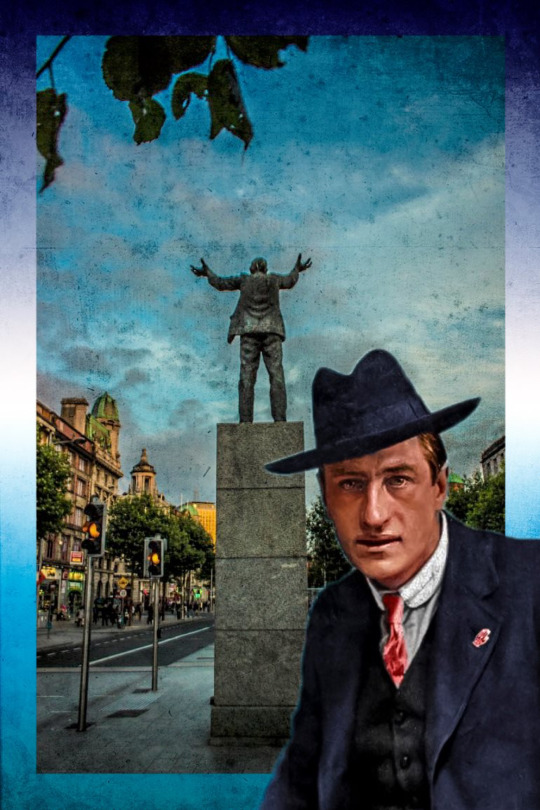
View On WordPress
#Belfast#Big Jim#Dublin#Dublin Lockout 1913#History of Ireland#Ireland#Irish History#Irish Transport and General Workers Union#James Connolly#Jim Larkin#Sean O’Casey#Stair na hÉireann#Union Leader
8 notes
·
View notes
Text
Yesterday marked the death of Sylvia Pankhurst - one of the finest revolutionary communists to have ever graced Britain's shores. We have rarely seen such fighters on this earth.
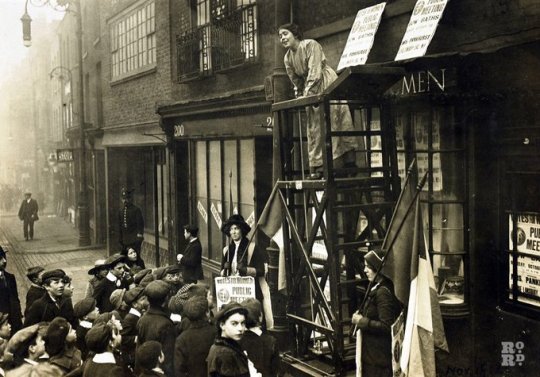
Sylvia was the most tortured suffragette, targetted for her insistence on including working class women within the demands of women's suffrage (much to the disdain of her mother and sister). She did not balk against repeated forced feeding, hunger striking and sleep striking.
She was one of a handful of communists in Britain who opposed the first world war. Her criticism of the war was ceaseless. Practically isolated, she organised relief for working class people in London with cost-price restaurants, free child care for mothers, and more.
She broke with the Labour Party over this, and never returned despite the enormous pressure put upon her by the British labour movement and, later, the Third Internationale. Her arguments with Lenin remain a key debate in communist and British politics.
Pankhurst stood resolutely with the Bolshevik revolution at its outbreak, and was pivotal in organising the "Hands Off Russia" campaign in Britain - which culminated in dock workers across the country refusing to load any munitions to ships.
Pankhurst was an outspoken opponent of racism. Her newspaper - then the Worker's Dreadnought - was the first newspaper in Britain to hire black journalists. When articles written by the Jamaican journalist, Claude McKay, were viewed as seditious, she went to jail for him.
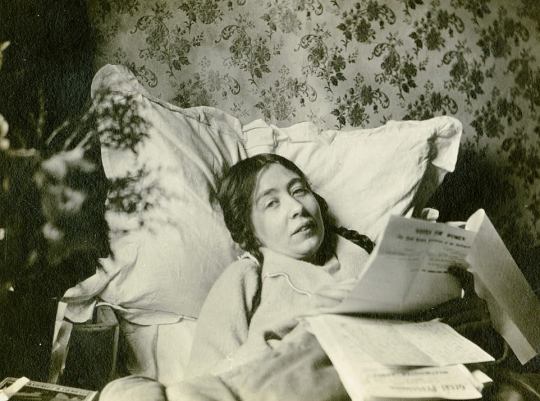
Her support for Irish independence never wavered. She supported Larkin, the Irish Transport and General Workers' Union and United Builders' Labourers Union during the Dublin lock-outs. She stood by the Irish Citizen Army during the Easter Rising.
She was one of the first in Britain to recognise the dangers of fascism, her warnings and agitation beginning as early as 1920. Through this struggle, she became deeply involved in Ethiopian national liberation, where she spent the last years of her life.
All of this is just the tip of the iceberg of the contributions Sylvia made in her life. She did all of this at great cost to herself, enduring her mother and sister denouncing her in the press repeatedly, endless slander, rejection by the mainstream communist movement and worse.

Sylvia also belongs to the great pantheon of disabled revolutionaries, being diagnosed with endometriosis whilst in prison. This, along with the damage done to her organs by forced feeding, left her with often crippling stomach problems.
"I am going to fight capitalism even if it kills me. It is wrong that people like you should be comfortable and well fed while all around you people are starving." She fought until she died, but capitalism didn't kill her. At aged 78, Sylvia passed on.
She was given a state funeral in Ethiopia, and remains the only foreigner buried in the front of Holy Trinity Cathedral. An Ethiopian migrant, cited anonymously in Rachel Holmes' biography of Pankhurst, summed up what she meant to him thus:
"After God, Sylvia Pankhurst".

To learn more about Sylvia, we highly recommend Rachel Holmes' biography, "Sylvia Pankhurst: Natural Born Rebel".
#sylvia pankhurst#communism#politics#marxism#philosophy#communist#anti imperialism#history#leftism#world history#working class#feminism#womens rights#smash the patriarchy#suffragette#suffragists#women's suffrage
105 notes
·
View notes
Photo

On this day, 24 January 1919, staff and patients barricaded themselves inside the Monaghan Lunatic Asylum in Ireland and declared a soviet (workers' council). The asylum workers had already shown militancy during a 1918 strike when they chased away visiting staff who attempted to cross the picket line. By 1919, attendants and nurses were working a 93-hour week and earning just £60-£70 per annum. They invited Peadar O'Donnell, a leading militant in the Irish Transport and General Workers Union, to negotiate on their behalf. And when negotiations failed to resolve their grievances, they hoisted the red flag and ran the asylum in cooperation with the patients. O’Donnell implemented a 48-hour working week and locked one attendant in a padded cell for “defeatism.” The staff and patients showed extraordinary resolve to maintain the occupation even when surrounded by 125 armed police. Unusually, no great animosity seems to have existed between police and strikers, and during the occupation they co-organised dances and football matches. Nevertheless, when a rumour circulated that military police were about to force entry, the occupiers sealed windows, barricaded corridors, swapped clothes with patients (to confuse the attackers), and attempted to arm themselves with shovels, spades, and pitchforks. When authorities offered to meet wage demands for male workers only, the occupiers refused to concede, insisting on parity for women workers. In the end, the standoff was resolved peacefully, with the total capitulation of the Asylum Committee. The occupiers held a victory dance in one of the dining halls, which was attended by many local townspeople as well as some of the police force. The following morning, February 4, they returned to work. * If you value our work researching and promoting people's history like this, if you can, please consider supporting our work on patreon and getting access to exclusive content and benefits: https://patreon.com/workingclasshistory https://www.facebook.com/workingclasshistory/photos/a.296224173896073/2193720497479755/?type=3
151 notes
·
View notes
Video
youtube
On June 5th 1868 James Connolly, Irish freedom fighter and socialist was born at 107 Cowgate Eindburgh,
Born to Irish Immigrant parents, James Connolly joined the British Military at age 14 to escape his extreme poverty. Seven years later at the age of 21, Connolly left military life and eventually settled in Dublin in 1896.
In 1903 Connolly emigrated to the United States,living for a brief period in Troy New York with a relative, and worked for an insurance firm as a salesman. But by 1905 he left Troy to persue his ideals of organizing a militant working class movement and soon joined the newly formed IWW ( Industrial Workers of the World ), as a member and full-time organizer. Connolly worked primarily in the New York City / Newark New Jersey area, and was a family friend of Elizabeth Gurley Flynn.
A prolific writer of historical, cultural, political, economic, and social analysis, as well as a one man editor and publisher of his own books and newspaper, many people of opposing political beliefs within the Labour movement and the Left valued and praised Connolly’s insightful views. His most famous book, Labour in Irish history , did not limit itself to Ireland, and included analysis of the horrible conditions of the British working class and the need for world-wide working class revolution.
He returned to Ireland in 1910 and became an organizer for the Irish Transport and General Workers Union ( ITGWU ). In 1913 along with Jim Larkin. Connolly organized a general strike in Dublin that paralyzed commerce and transport for many weeks. During the general strike Connolly organized the Irish Citizen Army amongst striking workers, in a self defense response to wide spread beatings of striking workers by the Irish police and British military. The Irish Citizen Army became the nucleus of the Dublin Division of the Army of the Republic during the 1916 Easter Rebellion against British rule of Ireland. After a week of intense fighting, the Easter Rising finally came to an end on April 29th, following the rebels’ surrender. A total of 450 people were killed in the action, with over half of these civilians. More than 200 buildings had been damaged, at a cost of almost £3million.
The carnage caused by the insurrection left the public feeling angry and hostile towards the rebels. Once the rebels surrendered, they were marched through the streets of Dublin. On their march, the soldiers were subjected to continual abuse from unsympathetic onlookers.Over 3,500 suspected volunteers were arrested. All but 579 were later released on the grounds that they posed no danger to the state. The irrational arrest of so many innocent people provoked outrage among the public. The next morning, the leaders of the Rising were taken to Kilmainham Gaol.Between May 2nd and 12th a total of 14 men were shot.
James Connolly was the last to be executed on the 12th of May. He had been badly injured in the Rising after a sniper bullet shattered his ankle, and the wound later became infected and gangrenous. Because of his injuries, Connolly had to be tried in the military hospital at Dublin Castle, and brought to Kilmainham by military ambulance for his execution.
He was unable to stand and even too weak to sit, so he was strapped down to a chair before he was shot.
11 notes
·
View notes
Text
Echoes of our Past | January 13th 1923
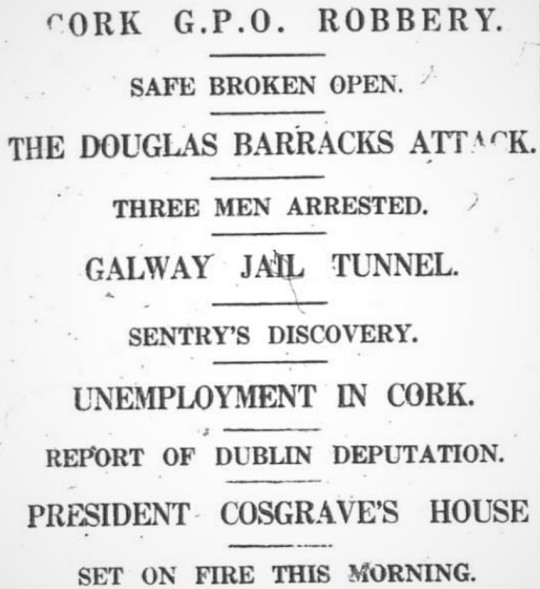
Librarian Richard Forrest takes a look at news highlights published in The Echo 100 years ago this week.
Cork Dockers Meet
The Cork dockers, coal carmen and storemen’s sections of the I.T.G.W.U. (Irish Transport and General Workers Union) met last night at Connolly Hall. The proceedings were protracted and concerned the proposed reduction of one shilling per day for time workers and a pro rata reduction for tonnage workers. It was agreed that a ballot on the issue be taken today. The ballot will close at 7 o’clock this evening and the result is expected to be announced at 9 tonight.
City Robberies Continue
Alarming robberies continue in the city. Buckley’s bedding manufactory on Lavitt’s Quay was entered by armed intruders as the workmen were being paid. Mr. Buckley strongly protested to no avail. Fortunately, some of the men had already received their pay and left. A somewhat mysterious robbery occurred at the G.P.O. last night. The postal side was locked up as usual at about 11 o’clock and everything reported to be in order. But when staff arrived this morning it was found that the safe had been broken into and bundles of £1 and 10 shilling notes amounting to £300 removed. A large amount of silver was left untouched.
Cork Quarter Sessions
Before the Honourable the Recorder of Cork K.C. Cornelius O’Sullivan, 1 Coburg Street, sought to recover the upper part of his house from James O’Sullivan, 1 Coburg Street. The evidence was that both had been tenants at the address to a Mrs. Vaughan. There was some controversy over a cellar which both claimed as part of their letting. Cornelius had since bought the entire premises and sought full possession to accommodate his family. Judgement was reserved.
President’s Residence Burned
Dublin was alarmed this morning by the news that President Cosgrave’s country residence at Rathfarnham has been destroyed by fire. Fortunately, no member of the Cosgrave family was at the residence at the time. For four hours the fire brigade battled with the flames and saved the servants section, the outhouses and much of the furniture. It seems that Republicans effected an entrance into the fine old Georgian mansion in the early hours and sprinkled petrol before initiating the conflagration. They detained a witness passer-by until the fire had gotten a firm hold. A caretaker occupying the lodge sixty yards away knew nothing about the outrage until awakened by the noise of falling masonry.
Sale of Arms
Washington – It is officially announced at the White House that no arms may be sold to any nation or any individual during President Harding’s administration.
Lunatic Asylum for Road Hogs
New York – The possibility of being sent to a lunatic asylum may have the effect of deterring “road hogs” pursuing their dangerous driving. This is the opinion expressed by Judge Charles L. Bartlett of Detroit who recently set a precedent by taking drivers guilty of excessive speed to the morgue to view the bodies of motor accidents. The Judge’s plan is to remand those found guilty for a mental test to be conducted by court appointed psychiatrist.
Viewing Venus
With the sun not rising till after 8 o’clock just now it is worthwhile rising a little earlier to see the planet Venus in all its glory. Epochs of maximum brightness are fairly frequent for Venus. They happen shortly before it reaches inferior conjunction when it dominates the eastern heavens as a morning “star”. Their greatest brilliance occur when the planet and the Earth are both almost at their nearest to the sun. These conditions obtain just now, the Earth making its nearest approach last Wednesday and Venus this Saturday.
Munster vs. Leinster
Munster and Leinster played at the Mardyke this afternoon. Leinster were unchanged but Popham declared off from Munster and was replaced by O’Neill. Munster’s players were selected from Dolphin (6), Constitution (5) and U.C.C. (3). Leinster’s from Trinity College (6), Landsdowne (4), Bective (2), Wanderers (2) and Monkstown (1). Play commenced in good style with Favier making a clever dash to Leinster’s 25 before being pulled down. Cussen cleared. Midfield play followed for some time and Munster were awarded a free for offside but Daly’s kick fell short. The Leinster forwards made a few bursts. A heeled free by Murphy-O’Connor restored play to midfield. A fine passing movement by Leinster was the next feature ending in Cussen scoring. Crichton failed to add the extra points. Splendid footwork from the Munster forwards, Bradley and Sullivan, followed and ended between the posts. O’Connell failed to convert, dashing the ball against the upright. After 20 minutes the score was level at three points each. Leinster pressed hotly for some time and Munster were penalised. A magnificent Munster movement was witnessed when Murphy-O’Connor gained possession, cut through beautifully and sent out to Favier when tackled by Davies. Favier was then pulled down but let the ball loose. Wellwood saved Munster from touch and Sullivan led the forwards to the line, scoring himself from far out. Daly failed to convert. Munster 3 tries (9 points); Leinster 1 goal 1 try (8 points).
1921 All-Ireland Final
A special meeting of the G.A.A. Central Council has fixed the 1921 All-Ireland hurling final between Limerick and Dublin for March 4th at Croke Park. Mr. Walsh, Waterford, to referee. The Council also decided to inaugurate a May 21st carnival in aid of funds.
Ode to the Coal Quay
Were I sublime than the Grecian Rhymer,
Than Philostratus or bold Bonaparte,
Could I when lyrical like Moore, that miracle,
Endow my dialect with tuneful art,
I’d pen a ditty of this fine fair city,
So wise and witty t’would beget renown:
And like thrush or curlew I’d extol that purlieu –
The Coal Quay Market of my native town.
(First of ten verses by W.B. Guinee, one time Cork journalist who moved to London)
2 notes
·
View notes
Text
Cork
Standing outside Cork County Hall is a pair of statues of two men looking up at a tall building. The only information about the statues is on a nearby plaque on which it is stated that it was a gift from the Irish Transport and General Workers Trade Union – a curious fact in itself!

The Sculpture on the County Hall Plaza ‘Two Working Men’ (image thesilvervoice)
In the courtyard of The…
View On WordPress
#Cha and Miah#Children of Lir#Cork County Hall#Gardens of Remembrance#Irish Transport & General Workers Union#Jim Larkin#Lee Baths#Oisín Kelly#The Kingsley Hotel
0 notes
Photo

7 notes
·
View notes
Photo

James (Jim) Larkin statue in Dublin, Ireland
James Larkin (21 January 1876 – 30 January 1947), AKA Jim Larkin, was an Irish republican, socialist and trade union leader. He was one of the founders of the Irish Labour Party, the Irish Transport and General Workers' Union (ITGWU), the Workers' Union of Ireland (the two unions later merged to become SIPTU, Ireland's largest trade union) and the Irish Citizen Army.
Source: https://en.wikipedia.org/wiki/James_Larkin
3 notes
·
View notes
Text
Events 11.21
164 BCE – Judas Maccabeus, son of Mattathias of the Hasmonean family, restores the Temple in Jerusalem. This event is commemorated each year by the festival of Hanukkah. 235 – Pope Anterus succeeds Pontian as the nineteenth pope. During the persecutions of emperor Maximinus Thrax he is martyred. 1009 – Lý Công Uẩn is enthroned as emperor of Đại Cồ Việt, founding the Lý dynasty. 1386 – Timur of Samarkand captures and sacks the Georgian capital of Tbilisi, taking King Bagrat V of Georgia captive. 1620 – Plymouth Colony settlers sign the Mayflower Compact (November 11, O.S.) 1676 – The Danish astronomer Ole Rømer presents the first quantitative measurements of the speed of light. 1783 – In Paris, Jean-François Pilâtre de Rozier and François Laurent d'Arlandes, make the first untethered hot air balloon flight. 1789 – North Carolina ratifies the United States Constitution and is admitted as the 12th U.S. state. 1861 – American Civil War: Confederate President Jefferson Davis appoints Judah Benjamin Secretary of War. 1877 – Thomas Edison announces his invention of the phonograph, a machine that can record and play sound. 1894 – Port Arthur, China, falls to the Japanese, a decisive victory of the First Sino-Japanese War; Japanese troops are accused of massacring the remaining inhabitants. 1902 – The Philadelphia Football Athletics defeated the Kanaweola Athletic Club of Elmira, New York, 39–0, in the first ever professional American football night game. 1905 – Albert Einstein's paper that leads to the mass–energy equivalence formula, E = mc², is published in the journal Annalen der Physik. 1910 – Sailors on board Brazil's warships including the Minas Gerais, São Paulo, and Bahia, violently rebel in what is now known as the Revolta da Chibata (Revolt of the Lash). 1916 – Mines from SM U-73 sink the HMHS Britannic, the largest ship lost in the First World War. 1918 – The Flag of Estonia, previously used by pro-independence activists, is formally adopted as the national flag of the Republic of Estonia. 1918 – The Parliament (Qualification of Women) Act 1918 is passed, allowing women to stand for Parliament in the UK. 1918 – A pogrom takes place in Lwów (now Lviv); over three days, at least 50 Jews and 270 Ukrainian Christians are killed by Poles. 1920 – Irish War of Independence: In Dublin, 31 people are killed in what became known as "Bloody Sunday". 1922 – Rebecca Latimer Felton of Georgia takes the oath of office, becoming the first female United States Senator. 1927 – Columbine Mine massacre: Striking coal miners are allegedly attacked with machine guns by a detachment of state police dressed in civilian clothes. 1942 – The completion of the Alaska Highway (also known as the Alcan Highway) is celebrated (however, the highway is not usable by standard road vehicles until 1943). 1944 – World War II: American submarine USS Sealion sinks the Japanese battleship Kongō and Japanese destroyer Urakaze in the Formosa Strait. 1945 – The United Auto Workers strike 92 General Motors plants in 50 cities to back up worker demands for a 30-percent raise. 1950 – Two Canadian National Railway trains collide in northeastern British Columbia in the Canoe River train crash; the death toll is 21, with 17 of them Canadian troops bound for Korea. 1953 – The Natural History Museum, London announces that the "Piltdown Man" skull, initially believed to be one of the most important fossilized hominid skulls ever found, is a hoax. 1959 – American disc jockey Alan Freed, who had popularized the term "rock and roll" and music of that style, is fired from WABC radio over allegations he had participated in the payola scandal. 1961 – The "La Ronde" opens in Honolulu, first revolving restaurant in the United States. 1962 – The Chinese People's Liberation Army declares a unilateral ceasefire in the Sino-Indian War. 1964 – The Verrazano-Narrows Bridge opens to traffic. At the time it is the world's longest bridge span. 1964 – Second Vatican Council: The third session of the Roman Catholic Church's ecumenical council closes. 1967 – Vietnam War: American General William Westmoreland tells news reporters: "I am absolutely certain that whereas in 1965 the enemy was winning, today he is certainly losing." 1969 – U.S. President Richard Nixon and Japanese Premier Eisaku Satō agree on the return of Okinawa to Japanese control in 1972. The U.S. retains rights to bases on the island, but these are to be nuclear-free. 1969 – The first permanent ARPANET link is established between UCLA and SRI. 1970 – Vietnam War: Operation Ivory Coast: A joint United States Air Force and Army team raids the Sơn Tây prisoner-of-war camp in an attempt to free American prisoners of war thought to be held there. 1971 – Indian troops, partly aided by Mukti Bahini (Bengali guerrillas), defeat the Pakistan army in the Battle of Garibpur. 1972 – Voters in South Korea overwhelmingly approve a new constitution, giving legitimacy to Park Chung-hee and the Fourth Republic. 1974 – The Birmingham pub bombings kill 21 people. The Birmingham Six are sentenced to life in prison for the crime but subsequently acquitted. 1977 – Minister of Internal Affairs Allan Highet announces that the national anthems of New Zealand shall be the traditional anthem "God Save the Queen" and "God Defend New Zealand". 1979 – The United States Embassy in Islamabad, Pakistan, is attacked by a mob and set on fire, killing four. 1980 – A deadly fire breaks out at the MGM Grand Hotel in Paradise, Nevada (now Bally's Las Vegas). Eighty-seven people are killed and more than 650 are injured in the worst disaster in Nevada history. 1985 – United States Navy intelligence analyst Jonathan Pollard is arrested for spying after being caught giving Israel classified information on Arab nations. He is subsequently sentenced to life in prison. 1986 – National Security Council member Oliver North and his secretary start to shred documents allegedly implicating them in the Iran–Contra affair. 1992 – A major tornado strikes the Houston, Texas area during the afternoon. Over the next two days the largest tornado outbreak ever to occur in the US during November spawns over 100 tornadoes. 1995 – The Dayton Agreement is initialed at the Wright-Patterson Air Force Base, near Dayton, Ohio, ending three and a half years of war in Bosnia and Herzegovina. 1996 – Humberto Vidal explosion: Thirty-three people die when a Humberto Vidal shoe shop in Río Piedras, Puerto Rico explodes. 2002 – NATO invites Bulgaria, Estonia, Latvia, Lithuania, Romania, Slovakia and Slovenia to become members. 2002 – Arturo Guzmán Decena, founder of Los Zetas and high-member of the Gulf Cartel, was killed in a shoot-out with the Mexican Army and the police. 2004 – The second round of the Ukrainian presidential election is held, giving rise to massive protests and controversy over the election's integrity. 2004 – Dominica is hit by the most destructive earthquake in its history. The northern half of the island sustains the most damage, especially the town of Portsmouth. In neighboring Guadeloupe, one person is killed. 2004 – The Paris Club agrees to write off 80% (up to $100 billion) of Iraq's external debt. 2006 – Anti-Syrian Lebanese politician and government minister Pierre Gemayel is assassinated in suburban Beirut. 2009 – A mine explosion in Heilongjiang, China kills 108. 2012 – At least 28 are wounded after a bomb is thrown onto a bus in Tel Aviv. 2013 – Fifty-four people are killed when the roof of a shopping center collapses in Riga, Latvia. 2013 – Massive protests start in Ukraine after President Viktor Yanukovych suspended signing the Ukraine–European Union Association Agreement. 2014 – A stampede in Kwekwe, Zimbabwe caused by the police firing tear gas kills at least eleven people and injures 40 others. 2015 – The government of Belgium imposed a security lockdown on Brussels, including the closure of shops, schools, public transportation, due to potential terrorist attacks. 2017 – Robert Mugabe formally resigns as President of Zimbabwe, after thirty-seven years in office. 2019 – Israeli Prime Minister Benjamin Netanyahu is indicted on charges of bribery, fraud, and breach of trust.
4 notes
·
View notes
Text
The Second Slavery: How the Democratic North Kept Their Foot on Your Neck
Our nation has erupted in days-long protest, sparked by the murder of George Floyd by four Minneapolis police officers. Cities across the U.S., and even across the world have taken to the streets to make their voices heard. Some of the most violent clashes between protestors and police have happened in Brooklyn, Los Angeles and Atlanta where we saw two college students being pulled from their vehicle and attacked by police. What also can’t be ignored is the systematic lockdowns of cities where mayors along with local law enforcement have declared citywide curfews, oftentimes making these announcements within minutes of said curfews expiring. Chicago has even taken to shutting off their CTA public transportation, which left many essential workers and protestors stranded on the evening of May 31, 2020. Speaking of, May 31st is the anniversary of the bombing of Black Wall Street in Tulsa, Oklahoma which took place in 1921. As we commemorate the 99 year anniversary of the bombing of Black Wall Street where a town of successful Black families and businesses were not only terrorized but ultimately destroyed, Black people in America must dissect and investigate the other foot on their collective necks - the collusion of our government, politicians, and police organizations with immigrant populations enabling them establish wealth in the same way as our country’s forefathers - on the backs of Black people.
The south has an overt and often open racist history that has been on display for centuries, along with the legacy of slavery. The North, however, in places like Boston, New York City, Chicago, Philadelphia and many other cities is where the mob and mafia organized crime ran rampant and were also integral in institutionalizing racism against Black Americans. These same machines created unions that were politically connected to the Democratic party who aided and abetted in the financial rape of the African American community by denying them union jobs, adequate housing and worked with the police unions to keep Blacks ‘in line’. Jimmy Hoffa’s Teamsters routinely provided interest free loans to the Mafia. The movie Harlem Nights depicts many of how this was orchestrated, including purposely inundating Black neighborhoods with illegal activities such a prostitution and gambling, typically for about a period of 5 years or so before having massive raids to take down Black crime bosses, only then to evict the residents so that White immigrant populations could come in and buy cheap real estate that would almost always skyrocket in value. These same immigrants came to despise and discriminate against the very African Americans who made it possible for them to come to this country.
It’s kind of disheartening to see the lengths that Ray, Quick, and their circle have to go because a White criminal, who has a dirty detective on his side, wants a piece of their pie.
(nerdist)
The Immigration Act of 1965 was a direct result of the Civil Rights movement organized and executed by Black / African Americans - “Over the next four decades, the policies put into effect in 1965 would greatly change the demographic makeup of the American population, as immigrants entering the United States under the new legislation came increasingly from countries in Asia, Africa and Latin America, as opposed to Europe.” This facilitated the acceptance of many immigrants of color to the United States. Once on these shores, parents of immigrant children often discouraged their children fraternizing, emulating or dating African Americans.
https://twitter.com/keilahhhjd/status/1267199334296109056?s=21
In addition, almost all of these immigrant groups profited from the same types of organized crime that had benefited their white immigrant predecessors such as the Irish, Italians, Russians and many more of European origin. Money laundering, bootlegging, prostitution and many other illegal activities directly funded many of what are now established businesses, suburban enclaves full of homes and lifestyles that their descendants enjoy. The origins of the Mob in America can be traced to the urban ghettos of the late 19th century where Irish, Italian and Eastern European Jewish immigrants struggled to survive amid poverty, overcrowding and discrimination. These immigrants could get only the most dangerous and low-paying jobs (source: themobmuseum.org). The movie, Gangs of New York depicts much of this history, “The Irish Bowery Boys soon formed in a nearby area known as the Bowery. Battles between the Bowery Boys and Dead Rabbits (claiming more than 1,000 members each) were legendary, each of which was supported by smaller gangs they had spawned...Shrewd politicians immediately recognized the potential asset that the street gangs might represent. In the early 1830’s, several politicians (ward and district leaders) bought grocery stores in Five Points and the saloons and dance halls in the Bowery, the gathering places for the gangs. In return for their assured protection of the gangs’ meeting places, and financial rewards offered to the gangs for their loyalty, gang leaders returned the favor by taking care of jobs like blackjacking political opponents and scaring unsupporting voters away from the polls” (source: sagepub.com).
Philadelphia and Boston could also lay claim to having substantial street gangs before the Civil War; [sic] Philadelphia’s Public Ledger identified nearly 50 Philadelphia gangs between 1840 and 1870. These gangs persisted; a New York Tribune reporter described the northern suburbs of Philly in 1948 and 1949 as swarming with gangs.
“If any nationality has been linked to organized crime in the UnitedStates over the years, it would have to be Italian-Americans, at least in popular perception...countless books, movies and TV shows, from The Godfather right up to the Sopranos, the image of the Mafioso has become synonymous with the face of gangsters in America.” However, the Irish Mob began as penniless immigrants in the mid-19th century battled their way to power and established the first crime syndicate in America, which lasted for at least 150 years (source: toledoblade.com). The first gang leader from the streets to achieve prominence was John Old Smoke Morrisey, who ran gambling joints, saloons, and brothels in New York City, ultimately aligning himself with Tammany Hall, the city’s corrupt Democratic political machine. Of course the best known Irish (democratic) family is the Kennedy clan. Boston native Joseph P. Kennedy, father of JFK and Robert Kennedy was a bootlegger during Prohibition who supplied liquor to a rogue gallery of crime bosses, including Al Capone. During his son’s presidential campaign, Joe reached out to mobsters for help and Sam Giancana, then the Mafia boss of Chicago, delivered the state of Illinois for JFK, helping provide his winning margin in the 1960 election. Decades later, the Russian mob, Colombians and Latin Americans became the face of organized crime in America.
While the Italian mafia was the largest and most powerful, other ethnic groups also had organized crime rings. On the west coast, especially there are Asian American gangs as well. In Koreatown in L.A. for example, the original gangs first came from Korea, and flourished by being involved in illegal activities such as drug dealing, organized crime, money laundering and prostitution. Since the liberalization of the immigration laws of 1965, Chinatowns in the U.S. have experienced a consistent increase in their crime rates.
You will often hear the children and grandchildren and great grandchildren angrily tweet or disclaim aloud that their parents came to America AFTER slavery and that they “worked hard” to achieve financial and business success, therefore the idea of reparations is absurd and Black folks in America should follow suit and “work hard” as well. What’s so interesting is that all of this history of the corruption among immigrant organized crime and their collusion with politicians, government and law enforcement is not only documented but glorified in history, film and ironically rap music. Most recently one only has to look to last year’s The Irishman starring Robert DeNiro and Joe Pesce. The mob museum is literally an entire museum celebrating how these groups came to America, created a crime syndicate and created generational wealth, all while local politicians and police chiefs winked, shook hands, quietly collected their cut on their way to vacation in Miami with their families. These are the same cops with their foot on the necks of George Floyd, the same system that gave Jacob the Jeweler 2.5 years and a $50,000 fine while the BMF crime family serves 30+ years in prison. Who is really being protected and served?
We encourage all of you, especially those that live in major cities across the U.S. to do your own research of the history of organized crime and cross reference wealth and ownership of land and businesses in those same cities. It is only then that you will truly connect the dots, especially as you fully realize how those actions contribute to denial of home loans, redlining, poorly performing school districts etc. It was just prior to the murder of George Floyd gripping the nation that we were largely discussing the upcoming presidential election, an ornery white woman in Central Park. The south’s history of slavery, terrorism at the hands of the KKK and segregation are well documented, but the largely Democratic stronghold of the North has produced structural racism that is just as sinister if not worse. In the words of Joe Biden, “You Ain’t Black” if you don’t comprehend the second slavery created by the North which has largely contributed the conditions we now find ourselves in.
Other sources: csun.edu, repository.upenn.edu, pbs.org, wikipedia
#bmf crime family#george floyd#amy cooper#blm#black lives matter#the irishman#gangs of new york#protests#looting#joe biden#donald trump#black wall st#ados#fba#african americans
1 note
·
View note
Text
The True History Behind Martin Scorsese's 'The Irishman'
https://sciencespies.com/history/the-true-history-behind-martin-scorseses-the-irishman/
The True History Behind Martin Scorsese's 'The Irishman'
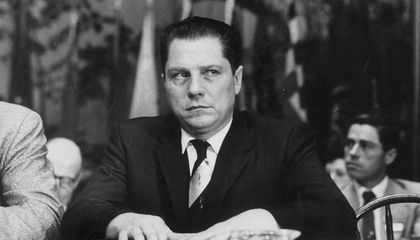
Martin Scorsese’s The Irishman provides a decades-spanning look at one man’s relationship to organized crime, organized labor, and the truth—however slippery that concept may be. That man, Frank Sheeran, played by Robert De Niro, was a union official and mob associate whose story intersects with labor organizer Jimmy Hoffa, the Mafia, and the Kennedys. The film, Scorsese’s first to stream exclusively on Netflix, is adapted from the 2004 Sheeran biography I Heard You Paint Houses by writer Charles Brandt, in which Sheeran claims that he killed Hoffa, amongst other figures. Hoffa’s sudden disappearance in 1975 still looms large as one of America’s longest-standing unsolved mysteries.
Sheeran’s stories are seductive—he was friends with Hoffa (Al Pacino), and he was an associate of Russell Bufalino (Joe Pesci), a mob figure who indeed had ties to both Hoffa and other high-level mafia families. And while many Hoffa scholars think Sheeran’s claims are bogus, and that Scorsese—and Robert De Niro, who has wanted to adapt the book for years—got the story wrong, the film’s portrait of how organized crime became interwoven with the labor movement and the highest levels of government in the 20th century carries many elements of truth.
youtube
As a guide to that era, here’s a primer that can either provide you with some key background information before sitting down to watch The Irishman or to fill in the gaps after viewing. The movie, which leaves theaters next week and will be available on Netflix starting Wednesday, November 27, runs more than three hours, so you have a lot of historical ground to cover.
Who was Jimmy Hoffa and was he really the most famous man in America?
James Hoffa, mostly known by the media as Jimmy, was a labor organizer even in his early career—at 14, he dropped out of school to work full time, and as a teenager he organized fellow grocery store workers to challenge unfair treatment by managers and to advocate for higher wages. He joined the International Brotherhood of the Teamsters in 1932 when he was still a teen, and by 1957 was elected president of the union, which at that point represented nearly one million truck drivers and warehouse workers. At one point in The Irishman, a voiceover from De Niro’s Sheeran asserts that Hoffa, in the 1950s and ’60s, was more famous than Elvis or the Beatles. That’s not an exaggeration—in a time when nearly one-third of American workers belonged to a union, Hoffa was the movement’s most famous face and de facto voice. On July 30, 1975, Hoffa set out for a lunch meeting at a local restaurant, and when he hadn’t returned home by the next morning, his wife Josephine called police. No trace of Hoffa was seen after that day, and he was declared legally dead in 1982. While some thought he was murdered by mafia associates, others thought it might be rivals within the Teamsters, and another line of inquiry attempted to discover whether or not Hoffa, afraid for his life, vanished of his own accord.

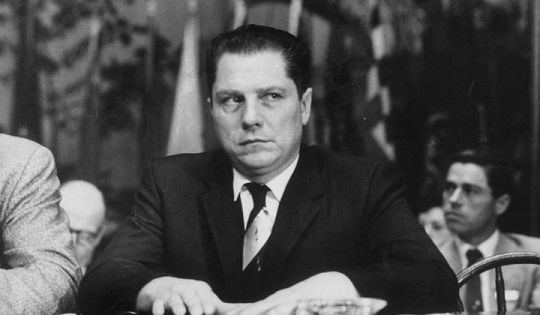
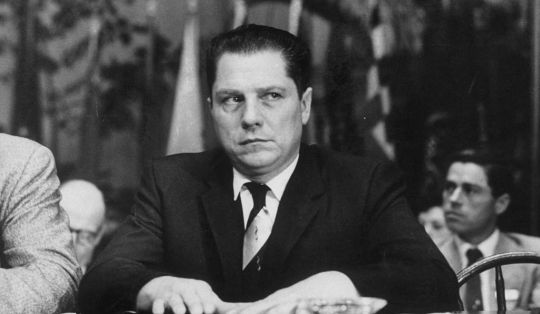

James R. Hoffa at the Teamster’s Union Convention
(Photo by Robert W. Kelley/The LIFE Picture Collection via Getty Images)
What did the Teamsters have to do with the Mafia?
In the mid-20th century, the Teamsters’ pension fund grew in size as membershipswelled. Many mafia families used this fund as a piggy bank, taking out off-the-books loans they’d use to fund the construction of casinos in Las Vegas (the mechanics of this story are detailed in Casino, another Scorsese film). “The problem with the loans to the Mob-controlled projects”, explained the National Museum of Organized Crime & Law Enforcement in a 2015 blog post, “was that many of them were not repaid promptly (or at all), and the corrupting influence facilitated ‘the skim’—the tax-free diversion of casino cash, delivered in suitcases to Midwestern mobsters.” Some of this cash made its way back to Hoffa and other union officials. At lower levels, mob enforcers would ensure unions won prime building, trucking, and transport contracts, keeping the flow of money steady. They would also pitch-in to help fix elections, either within the union itself or in city governments, ensuring key positions were held by union-friendly (and mob-friendly) candidates.
Who, then, was Frank Sheeran?
Many historians of the FBI, labor unions, and organized crime cast aspersions on Frank Sheeran’s stories that he killed Hoffa, or that he killed infamous “Crazy Joe Gallo” in Manhattan’s Little Italy in 1972. Writer and mafia historian Bill Tonelli, writing in Slate, exhaustively argues that Sheeran’s claims are mere fantasy: “Not a single person I spoke with who knew Sheeran from Philly—and I interviewed cops and criminals and prosecutors and reporters—could remember even a suspicion that he had ever killed anyone.”
But some of what Frank Sheeran says to Brandt in I Heard You Paint Houses is true—he was a close associate of mafia boss Russell Bufalino, and through Bufalino he did come to be well-acquainted with Jimmy Hoffa.
An Irish-Catholic WWII veteran, Sheeran, a truck driver by trade, began doing small jobs for Bufalino and the even higher-up Angelo Bruno (Harvey Keitel). As a non-Italian, he wasn’t eligible for full-fledged membership in the Cosa Nostra, but he was considered a trusted associate and friend by Bufalino. In I Heard You Paint Houses, Sheeran, who died in 2003, alleges that through Bufalino he became Hoffa’s right-hand man, tasked with protecting him on trips and even performing assassinations as necessary.
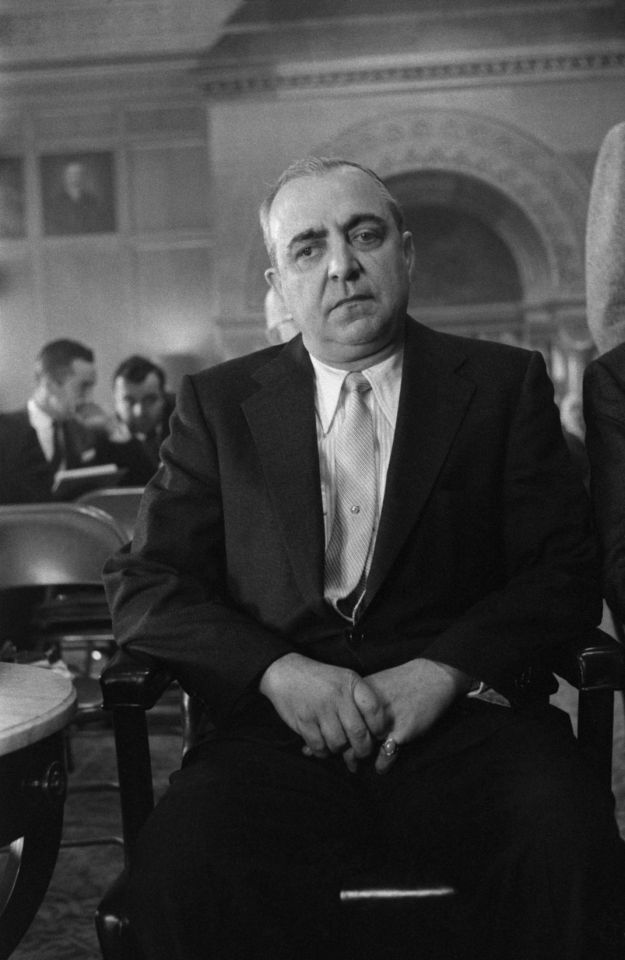
Russell Bufalino, of Kingston, Pennsylvania appears before the legislative watch dog committee during hearings in the Capitol on the Apalachin, New York, crime congress.
(Getty Images)
What role did Bufalino play in the Mafia hierarchy? Why was he important to the Hoffa story?
Born in Sicily in 1902, Russell Bufalino immigrated to the United States as a child. His family settled in Buffalo, New York, and after moving as a young adult to Northeastern Pennsylvania, Bufalino, by the mid-1960s, was the country’s most important mafia figure not based in a major city. His crew controlled Rust Belt communities like Wilkes-Barre and Scranton, Pennsylvania, and desolate stretches of highway that were useful to the mob because of both coal mining and long-haul trucking. Bufalino’s cousin, Bill (Ray Romano), meanwhile was Jimmy Hoffa’s personal attorney.
While never as notorious or prominent in the news as peers like Carlo Gambino or Joe Bonano, Bufalino was nonetheless a central figure in mid-century organized crime, and in the early 1970s was reportedly the interim head of the notorious Genovese family. As early as 1964, Bufalino was on law enforcement’s radar—a Senate subcommittee on organized crime called him “one of the most ruthless and powerful leaders of the Mafia in the United States.” In 1978 he was sentenced to four years in federal prison on an extortion charge, and was later sent back for an additional decade after a hitman he hired became a government informant. By all accounts, Bufalino and Sheeran remained close until the former’s release from prison in 1989, with Sheeran, convicted in the late 1970s of labor racketeering, continuing to act as Bufalino’s bodyguard and caretaker behind bars.
How did the Kennedys get involved in this story?
John F. Kennedy’s relationship with the mafia is probably second only to his relationship with Marilyn Monroe in terms of public fascination. While little direct evidence connects Kennedy patriarch Joseph P. Kennedy, Sr. to the bootlegging industry of the Prohibition age, he was a shrewd Wall Street investor and, later, Hollywood power player—he made several films in the 1920s with star Gloria Swanson (who also happened to be his mistress). At various points Kennedy served as the chairman of the Securities and Exchange Commission and the U.S. Ambassador to the United Kingdom, and he used this political capital to help the careers of his sons. In The Dark Side of Camelot, journalist Seymour Hersh alleges that Kennedy also leveraged his influence with the Chicago mafia to secure JFK’s victory over Richard Nixon in the presidential election of 1960. Scorsese’s film presents these connections as fact, even bringing up the persistent—but still unsubstantiated—suggestion that JFK’s assassination was a mafia hit.
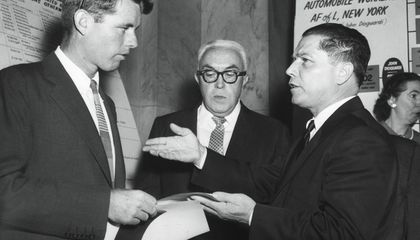
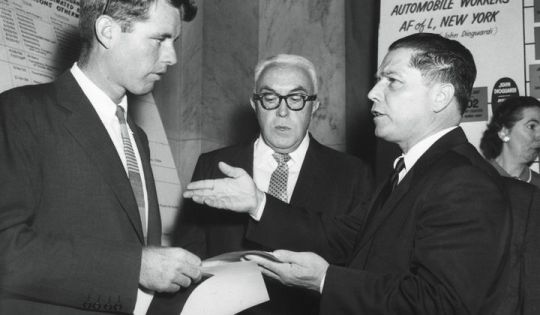
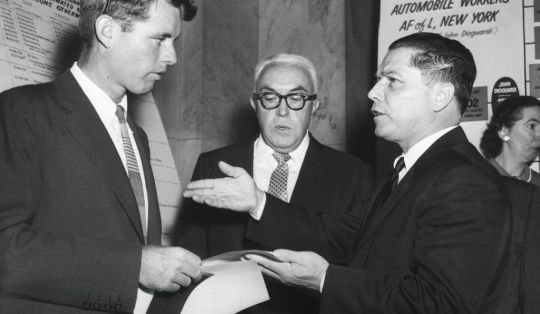

Robert Kennedy speaks with labor leader Jimmy Hoffa. Kennedy was chief counsel for the Senate Rackets Committee and investigated Hoffa’s ties to organized crime.
(Getty Images)
Where did Hoffa come into conflict with the Kennedy administration?
As soon as JFK installed his brother Robert as attorney general in 1961, Jimmy Hoffa shot to the top of the younger Kennedy’s personal Most Wanted list. A one-man anti-mob crusader, Kennedy and his team, Ronald L. Goldfarb outlines in 2002’s Perfect Villains, Imperfect Heroes, accused Hoffa of being little better than a mafia boss himself. He was charged at various points with bribery, fraud, and, most crucially, misuse of the pension fund, all while he tried to expand the Teamsters by bringing airline workers into the union.
According to Kennedy, Hoffa used the fund to make loans to organized crime figures across the country. More than political adversaries, the two men seemed to genuinely dislike each other. After a dinner with Hoffa, Kennedy reflected on the other man’s character: “On my way home I thought of how often Hoffa had said he was tough; that he destroyed employers, hated policemen, and broke those who stood in his way…When a grown man sat for an evening and talked continuously about his toughness, I could only conclude that he was a bully hiding behind a facade.” Kennedy, in this instance, prevailed—Hoffa was finally convicted of both fraud and bribery in 1964, and sentenced to 13 years in federal prison, though he got out in five thanks to a commutation by President Richard Nixon.
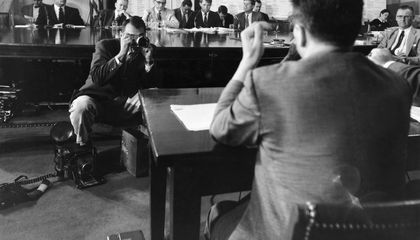
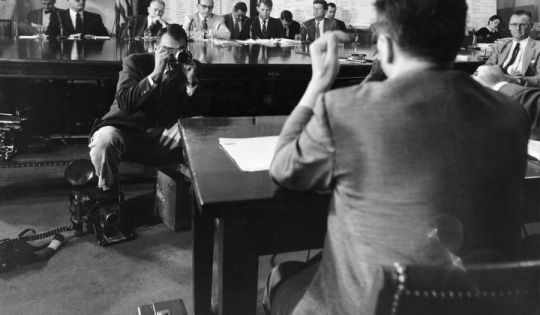
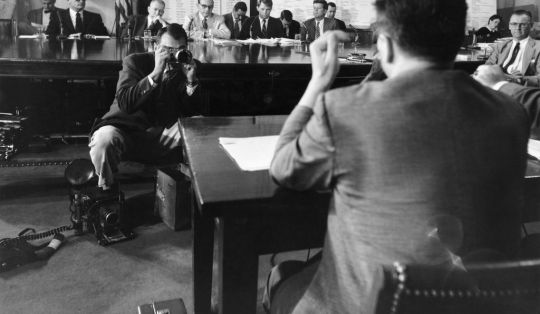

Facing the Senate Labor Rackets Committee for the fourth consecutive day, teamster boss James R. Hoffa testified today that he does not recall talking with racketeer Johnny Dio about the founding of seven phony teamster locals in New York. Council Robert Kennedy and Senator John F. Kennedy are seen in the background.
(Getty Images)
After his release from prison, Hoffa, still beloved by many in the Teamsters, attempted to take back his former position as head of the union. This is where most people believe he went wrong; many in the mafia believed Hoffa’s lust for power made him an unreliable associate. The initial investigations into his disappearance made it clear that Hoffa’s work was tied to the mystery: “Mr. Hoffa owes his fate, whatever it may be”, wrote the New York Times in 1975, “to his increasingly persistent efforts to restore his lapsed influence over the 2.2‐million member union that he built, almost single handedly, into one of the most potent economic and political forces in America.”
So if not Sheeran, who actually killed Jimmy Hoffa?
While not considered by contemporary law enforcement to be a primary suspect in Hoffa’s disappearance, Sheeran’s name did appear on the FBI’s initial list of suspects, but his relationship with Hoffa—and with Bufalino—means that he can’t be ruled out of having some connection to the crime, even if he didn’t pull the trigger himself.
In Hoffa lore, another name comes up regularly—Chuckie O’Brien, another of Hoffa’s longtime friends and aides. In 2004, the FBI matched Hoffa’s DNA to a hairbrush found in O’Brien’s car, though O’Brien’s stepson, lawyer Jack Goldsmith, vehemently denies O’Brien’s involvement. Most law enforcement sources agree that whoever actually killed Hoffa, the particulars Scorsese presents in The Irishman aren’t far off—Hoffa was killed after a meeting in a Detroit house, and his remains were either buried or cremated shortly thereafter.
More recently, in 2017, James Buccellato, a criminology professor at Northern Arizona University, reflected on some of the outlying ideas: “The craziest theory that I’ve ever heard was that he was actually, this was a while back, but that he was actually still alive and that he as being kept somewhere alive by the Mafia; sort of an ‘Elvis is still alive’ kind of theory.”
For his part, when pressed in an interview with Entertainment Weekly, Scorsese suggested that the truth of Hoffa’s disappearance is perhaps the least compelling part of the story: “What would happen if we knew exactly how the JFK assassination was worked out? What does it do? It gives us a couple of good articles, a couple of movies and people talking about [it] at dinner parties. The point is, it’s not about the facts. It’s the world [the characters are] in, the way they behave. It’s about [a character] stuck in a certain situation. You’re obligated to behave a certain way and you realize you may have made a mistake.”
#History
2 notes
·
View notes
Text
#OTD in 1913 – Also known as “The Great Dublin Lockout”, the Dublin Transport Strike, led by Jim Larkin and James Connolly, begins.
The Great Dublin Lockout starts and one of the most bitter and divisive labour disputes in Irish history will run until February 1914 when starving workers are forced back to work. Five years previously, in 1908, at a time when Irish labourers were working in atrocious conditions, Union organiser Big Jim Larkin founded the Irish Transport and General Workers Union (ITGWU). The 1913 Lockout…

View On WordPress
#AE Russell#Dublin#Dublin United Tramway Company#George Bernard Shaw#History of Ireland#Irish History#Irish Independent#Irish Transport and General Workers Union#ITGWU#James Connolly#Jim Larkin#Padraic Colum#Padraig Pearse#The Dublin Transport Strike#The Great Dublin Lockout#William Butler Yeats#William Murphy
8 notes
·
View notes
Text
An Irish Republican Mother, Margaret McGuinness Kelly 4th January 1904 --13th April 1983
An Irish Republican Mother, Margaret McGuinness Kelly 4th January 1904 --3rd april 1983
My Mother 1960s (above left my mother sitting and Winnie Carney standing this photo was taken after my mothers wedding. This is my late mother, Margaret McGuinness Kelly, born 4th January 1904 to William McGuinness and Mary McClean who both were founding members of the Irish Transport and General Workers Union in Belfast along with her mother’s (my grandmother) brother Alfie McClean who was to…
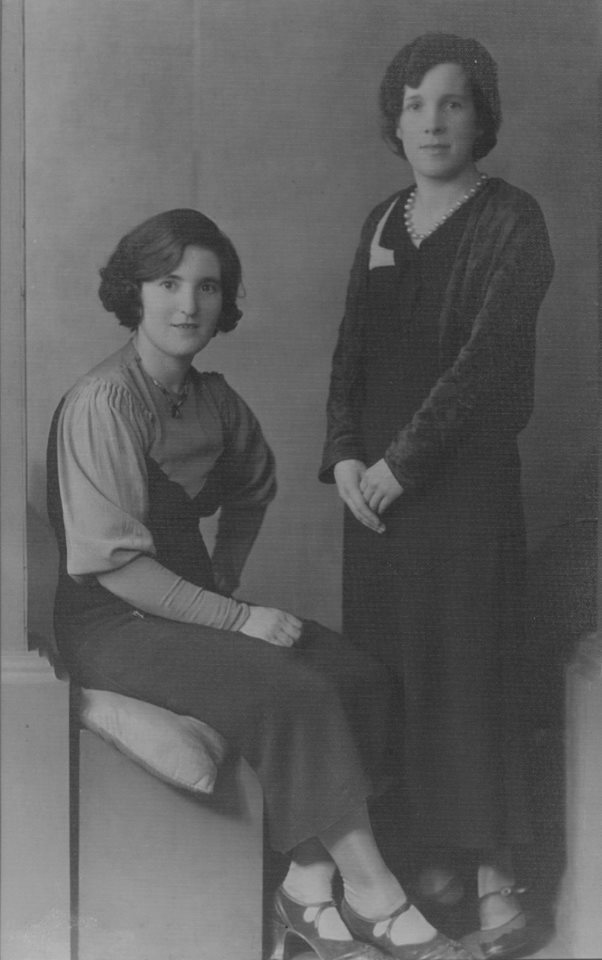
View On WordPress
0 notes
Photo

On this day, 1 December 1921, striking workers at Castleconnell fisheries in Ireland occupied their workplace and declared a soviet (workers council). The following day at a Dáil cabinet meeting, labour minister Constance Markiewicz was instructed to contact the Irish Transport and General Workers' Union (ITGWU) and inform them that the soviet would be suppressed by the Irish Republican Army. Police and volunteers were also to be used to evict the strikers. However it appears this did not transpire, and the workers eventually vacated the premises voluntarily on December 22 after the boss agreed to arbitration, which later ruled in favour of the workers. Pictured: a soviet at Bruree Creamery, 1921 https://www.facebook.com/workingclasshistory/photos/a.296224173896073/2149224838595988/?type=3
113 notes
·
View notes
Photo


On June 5th 1868 James Connolly, Irish freedom fighter and socialist was born at 107 Cowgate Eindburgh,
Born to Irish Immigrant parents, James Connolly joined the British Military at age 14 to escape his extreme poverty. Seven years later at the age of 21, Connolly left military life and eventually settled in Dublin in 1896.
In 1903 Connolly emigrated to the United States,living for a brief period in Troy New York with a relative, and worked for an insurance firm as a salesman. But by 1905 he left Troy to persue his ideals of organizing a militant working class movement and soon joined the newly formed IWW ( Industrial Workers of the World ), as a member and full-time organizer. Connolly worked primarily in the New York City / Newark New Jersey area, and was a family friend of Elizabeth Gurley Flynn.
A prolific writer of historical, cultural, political, economic, and social analysis, as well as a one man editor and publisher of his own books and newspaper, many people of opposing political beliefs within the Labour movement and the Left valued and praised Connolly’s insightful views. His most famous book, Labour in Irish history , did not limit itself to Ireland, and included analysis of the horrible conditions of the British working class and the need for world-wide working class revolution. He returned to Ireland in 1910 and became an organizer for the Irish Transport and General Workers Union ( ITGWU ). In 1913 along with Jim Larkin. Connolly organized a general strike in Dublin that paralyzed commerce and transport for many weeks. During the general strike Connolly organized the Irish Citizen Army amongst striking workers, in a self defense response to wide spread beatings of striking workers by the Irish police and British military. The Irish Citizen Army became the nucleus of the Dublin Division of the Army of the Republic during the 1916 Easter Rebellion against British rule of Ireland. After a week of intense fighting, the Easter Rising finally came to an end on April 29th, following the rebels’ surrender. A total of 450 people were killed in the action, with over half of these civilians. More than 200 buildings had been damaged, at a cost of almost £3million. The carnage caused by the insurrection left the public feeling angry and hostile towards the rebels. Once the rebels surrendered, they were marched through the streets of Dublin. On their march, the soldiers were subjected to continual abuse from unsympathetic onlookers.Over 3,500 suspected volunteers were arrested. All but 579 were later released on the grounds that they posed no danger to the state. The irrational arrest of so many innocent people provoked outrage among the public. The next morning, the leaders of the Rising were taken to Kilmainham Gaol.Between May 2nd and 12th a total of 14 men were shot.
James Connolly was the last to be executed on the 12th of May. He had been badly injured in the Rising after a sniper bullet shattered his ankle, and the wound later became infected and gangrenous. Because of his injuries, Connolly had to be tried in the military hospital at Dublin Castle, and brought to Kilmainham by military ambulance for his execution. He was unable to stand and even too weak to sit, so he was strapped down to a chair before he was shot.
15 notes
·
View notes
Text
AND DUBLIN WEPT
They sent me out to Swords to get Willy O’Brien. I handed him the message and watched his lips form a tight line. He looked up, rubbed his nose where his glasses rested, then climbed into the cab of the lump of an Austin lorry I’d borrowed. We bounced along the road back to Dublin, the truck leapt and bucked on every rut and pothole but I drove as hard as I could. Willy was quiet. Every now and then he’d take out the bit of paper I’d given him and read it again.
Maybe he was hoping the words would change.
No survivors, he muttered once. Later, they’ll blame us. I turned to say something, but he wasn’t with me. He was watching Drumcondra through the rain.
It had been Jim Larkin’s idea to send the children to stay with the families of union men across the water. Archbishop Walsh had torn into him, said he wanted to turn the children into communists and atheists or, worse, protestants. But those youngsters got trampled on Sackville Street, the winter bit hard and the strike dragged on. No one wanted to watch their children suffer so, in the end, we could have filled the boat three times over.
I couldn’t get the lorry down Gardiner Street through the crowd, so we dumped it and jumped some fences to get to the back of Liberty Hall. The union’s headquarters was full of men smoking hard and staring at their feet, none of them wanting to look Willy in the eye. He paid no heed, barging his way to the front of the building. Larkin was on the steps with James Connolly beside him. Willy went out. I stopped in the doorway.
Beresford Place was heaving, the crowd pressed tightly to the foot of the hall’s low steps and stretched back over Butt Bridge and under the Loopline Bridge towards the old harbour. Rain was coming down in thick cords and sliding off the iron railway bridge in sheets, but no one seemed to care. They were quiet but not really listening to Larkin, who was waving his arms and roaring at them. He was talking politics and he’d lost them.
Hugh, a thick-necked Ulsterman, put a hurley in my hands and nodded towards Custom House. There was a different crowd moving in the gardens there. It was Murray’s Free Labour boys – scabs and strikebreakers – sensing an opportunity.
“Laaarkin, baby killer… Laaarkin, baby killer.”
Some of the crowd took up their chant and started to surge towards us. There was pushing and shoving and scuffles were breaking out. Larkin was still shouting about winning the strike.
A woman broke through the front of the crowd.
Her hair was wild, her bonnet trailing behind her. She had no coat on and her dress was soaked through. She was mad looking and one of our lads went to stop her, I pulled him away.
“William! Is it true William? Are our boys drowned?
Willy turned and I saw his knees go, and his face greyed. Whatever strength had been holding him up just evaporated. The two of them fell to the ground and she was screaming the names of her lost boys.
The scabs missed this. They pushed on, still shouting, but some wee woman turned round and slapped the first of them. All at once the grief in the crowd turned cold and hard and focused itself on Murphy’s men and it was only that they had the sense to go scrabbling back towards Custom House that saved them from a bad beating.
The people turned to us.
Larkin was ready to start again but Connolly put a hand on his shoulder, shaking his head. Some of the lads came over and helped to get Willy and his wife up and guide them into Liberty Hall. Connolly turned back to the crowd.
“We are, as we have always been, a people united by grief,” he said. “We are sorry for your loss.”
At last, Dublin wept.
The truth soon came out. The destroyer HMS Tartar had sailed up from Kingstown with orders to force the SS Connemara back to Greenore and the children back to Dublin. The sea had been rough, the captain of the Tartar had misjudged the currents in Carlingford Lough, and the ships collided. The British captain had panicked and steamed for port. The Connemara turned over and eight hundred children drowned less than a mile from shore.
Then Dublin burned.
“And Dublin Wept” was first published in Pandemonium: Big Jim’s Shadow, Jurassic London
BACKGROUND
In the early Twentieth Century Dublin was a rapidly growing city in which large numbers of workers endured abject poverty in disease-ridden slums. Two charismatic socialists, Jim Larkin and James Connolly, came together to build the Irish Transport and General Workers Union. They were romantic figures who live on in (near) legend and, indeed, song. The union grew quickly, alarming some of Dublin’s employers, led by William Martin Murphy – owner of, amongst other things, three newspapers and a tram company. In August the employers locked out tens of thousands of workers they suspected of being union members. A long, bitter and often violent dispute had begun.
Jim Larkin did suggest sending the children of Dublin’s strikers to England and Scotland to live with the families of union members. He hoped to ease the burdens on striking families but, more importantly, he hoped to spread support for the strike to the rest of the UK and thought the children would elicit sympathy. However, the combined forces of a hostile press and an equally hostile Catholic Church scuppered the idea.
The lock-out petered out in 1914, with both sides exhausted and forced to compromise. The ITGWU was badly damaged and things got worse when Larkin went off to North America and then, in 1916, James Connolly was killed by the British for his part in the Easter Rising (Murphy used his newspapers to agitate for the execution of his old adversary).
William X O’Brien was the man who emerged to rebuild the ITGWU, turning it into a major force in Irish politics. As far as I know no songs have been written about William X O’Brien.
The SS Connemara, a ferry plying the route from Greenore to Liverpool, did sink in Carlingford Lough but not until November 1916. All aboard were lost, including my great uncle, Private Robert Kenna, who was returning to France after recovering from injuries.
AND DUBLIN WEPT was originally published on Welcome To My World
0 notes